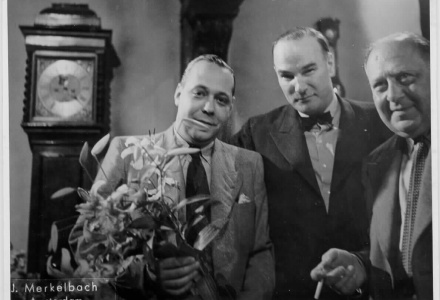Rudi Meyer and Dutch Film in the 1930s
At the beginning of 1937, Het Vaderland, a newspaper in The Hague, carried out a survey among 27 ‘insiders’ in the film world that asked whether a Dutch film industry had the right to exist. One of the participants was producer Rudolf (Rudi) Meyer, whose new film Pygmalion, featuring Lily Bouwmeester in the leading role, would play to sold-out theatres later that year. Meyer, who’d moved to the Netherlands in 1933 after the change of power in Germany, had already won much praise with his first production in the Netherlands, De kribbebijter. This film was the first in a series of light-hearted entertainment films that he made in the second half of the 1930s.
A viable industry?
In his answer to the survey question, Meyer emphasised that a Dutch film industry could only exist when films were regularly produced and if there was regular employment for those who made a living doing this sort of work.
Governmental support was essential, as well. In his opinion, film was an art form, to be sure, but one that was ‘subject to certain financial conditions’, considering that the production of a film demanded a large capital investment and financiers didn’t want to risk any losses, ‘even when they are filled with such enthusiasm’.
According to Meyer, his role as a filmmaker was to mediate between ‘the capital interests’ and the ‘artistic demands of the film’. He personally believed in the viability of a Dutch film industry and hoped that with the production of his most recent film he would be contributing to this.
Pygmalion comes to life
It seemed Meyer did just that with the success of Pygmalion, which was directed by Ludwig Berger whom Meyer had known in Germany.
Not only did audiences flock to see it, the press was also wildly enthusiastic about the film. ‘For the first time since the beginning of Dutch film industry, one can speak without compunction of a Dutch film par excellence’, wrote the Catholic film magazine 'Filmfront' – and there was more: ‘For the first time, actors and actresses speak and act in a natural way.
For the first time, sets and music are justified as living parts of a living whole. And what is most admirable in Berger’s film is the fact that he has managed to let the dialogue flow convincingly in the rhythm of the film’, according to the magazine.
After Pygmalion, Meyer made three more films with Lily Bouwmeester in the leading role: Vadertje Langbeen and Morgen gaat het beter!, directed by another German filmmaker, Friedrich Zelnik, and Ergens in Nederland directed by Ludwig Berger.
Especially in the latter two films, a shift can be seen from a light-hearted sort of entertainment to more serious social subjects and current events such as the mobilisation in Ergens in Nederland. Berger had planned to make a third film but when war broke out, this plan never materialised.
more information
If you are looking for more material from our collection, please contact
Ms. Leenke Ripmeester
sales@eyefilm.nl
phone +31 (0)20 5891 426
mobile +31 (0)6 4118 9635

